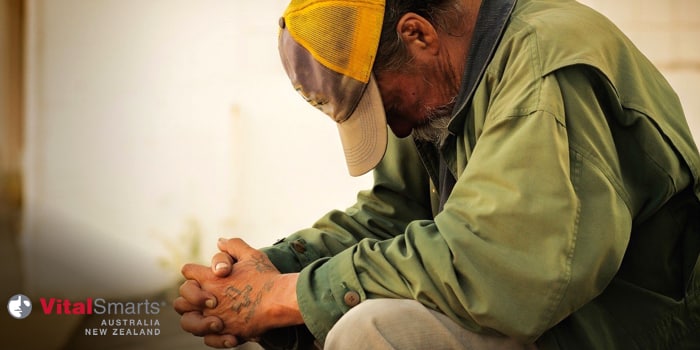Some conversations just aren’t good.
You have to confront an issue, deal with a problem, or hold someone accountable. These aren’t topics we enjoy talking about…
But they’re essential.
There are some moments in your life, leadership, and organisation that matter more than any others. These are moments of disproportionate influence — times when the way someone behaves has an enormous effect on every result you care about.
These are crucial conversations.
What Makes a Conversation Crucial?
Over the last 30 years of research, we found that moments demand a conversation when they have these three dimensions:
- High Stakes: There’s an issue that has high stakes to you.
- Different Opinions: You come into these moments expecting someone else to disagree with you. This causes you to behave differently than you otherwise would.
- Strong Emotions: These are moments of stronger, triggered emotions.
Crucial conversations affect the durability and happiness of your marriage, the strength of your executive team, and the performance of your organisation.
And their effect carries on long past that moment.
So, how do we face these issues?
First, before we can ever discuss the problem and expect to be heard by the other person, we have to make sure they know it’s safe.
If you can create safety, you can talk with almost anyone about almost anything.
Here’s an example of how it’s worked for me.
Creating Safety Over Time
The most crucial conversation of my life took place on December 28, 2009… or at least that’s when it finished. We began that conversation ten years earlier.
I met Patrick when he was 12 years old. He was a scout and I was a scout leader. As we camped and explored together over several years, I got to know him well.
Then, he disappeared. I became concerned so I started asking some of his buddies about him. They seem a little hesitant to answer. So, I cornered one and asked, “What happened to Patrick?”
He hung his head and answered, “I think Patrick is using drugs.”
I was worried so I tried to find him, but he avoided me. Eventually, I gave up.
Ten years later, I was enjoying a relaxing Saturday at home, when I heard a knock. When I opened the front door, I saw a bedraggled, weather-beaten character standing there. His mouth agape, he said nothing.
Then, I started to notice something about his eyes and face. Recognition washed over me.
I clapped him on the shoulders and said, “Patrick! It’s so good to see you!”
I welcomed him inside and led him over to the couch.
“Catch me up,” I said.
Over the next hour, he poured out his story of torment, bad decisions, addiction, and prison time. Then, he got to his point. “I’m tired of this. I want to turn my life around. And I don’t really have many people I can come to for advice. But, I always respected you, and I thought you might help me.”
“I’d be happy to help.”
We talked about some of his challenges. We created a plan. First, he needed a job to start paying his fines. He got a job, began paying off his fines, checked in with me regularly, and made real progress.
About three months later, he said, “I’m working a minimum wage job, but if I had transportation I could get to a construction job where I’d make more money.”
So we brainstormed another plan, I co-signed for a loan, and he bought an old truck. He got the construction job and things seemed to be going really well.
Then he disappeared again.
Creating Safety In the Moment
A while later, in October of that year, our house was burglarised. I was troubled for many reasons — it was a violation of our personal space, and I worried about the security of my family. So, my wife and I bought surveillance equipment so we could feel safe while I travelled.
It’s hard to describe the feelings I had when, in November of that year, our house was burglarised again. But this time, there was video evidence. I watched the burglar go into the backyard, drop in the window well, and emerge with some of our valuables.
It was Patrick.
On December 28, 2009, I was driving near our house when I saw Patrick walking along the sidewalk. I pulled up, rolled down the window, and said, “Hey Patrick.”
His eyes grew big, and he looked like he was about to sprint.
“Patrick, it’s okay. You don’t need to run. I just want to talk.”
Finally, his shoulders slumped in defeat, and he joined me in the car. We drove home, went down in the basement and sat down for a conversation.
Patrick didn’t say anything — he just stared at the ground.
I said, “Patrick, there’s something I need to show you. But, before I do, I need you to hear something. Will you look me in the eyes? I need to know you hear this.”
With great effort, he lifted his eyes and locked them on mine.
“Patrick, do you know that I love you?”
His eyes immediately filled with tears and he said, “Yes, I do.”
“Good. Do you know that I would never do anything if it weren’t in your best interest?”
His lip started to quiver as he said, “Yes, I do.”
“Good. There’s something I need you to see.”
I showed him the evidence and he started heaving and sobbing. “Patrick, I don’t think I would be a friend to you if I didn’t let you be held accountable for what you did to me and my family. I intend to share this with the police and it’ll be up to you how you address that.”
Through chokes and sobs, he said, “I know I need to go to jail, but will you be there for me when I get out?”
“Yes, I will.”
Safety Makes It Possible
If it’s possible for me to tell someone that I’m helping send him to jail and he can hear it, what else is possible for us to discuss?
Crucial conversations aren’t easy. They’re not about enjoyable topics and we don’t usually look forward to them. Yet these conversations change our lives.
But first, we have to create a safe place so we can have the conversations that matter most.





